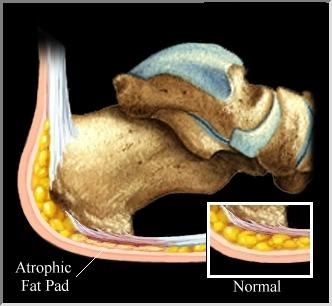
Fat Pad Atrophy
Synopsis
This is a condition that is common, it's not specific to runners, tri athletes, or training in general. It is basically a sore heel - the pain is concentrated over the center of the heel and it feels like a deep bruise. The natural design of the foot is incredible because not only are the bony arch and the plantar fascia created in such a way as to act as a shock absorber, but we also have about a 1 inch thick pad between our skin and the bone of the heel which acts as a cushion. This cushion is called a 'fat pad' because it's made up primarily of fatty tissue. The fat pad is kind of divided into sections by ligamentous 'baffles' which help keep the fat pad from spreading out and thereby aid in keeping the cushion where it belongs - under the heel. Occasionally, the heel can get injured and these baffles can become stretched and then the fat pad spreads out and we lose some of that cushion - which can make weight bearing very uncomfortable. Fortunately, it is treatable.

Diagnosis and Treatment
symptoms include:
Fat pad atrophy may or may not heal with time, its better to try to keep the pain to a minimum while it heals, which decreases the inflammatory process and promotes healing. You could continue to tape the heel with trainer's tape, however that is time consuming and can irritate the skin after a few applications. Alternatively, you should check your local running specialty store and ask if they carry a 'heel cup' which is a little plastic cup that surrounds the heel and presses the fat pad under the calcaneus. It should fit tight around the heel so that when you place you foot in your shoe it compresses the sides of the heel. If a heel cup doesn't work then sometimes a heel pad can be added to the shoe for extra cushioning. These are basically little foam or gel pads that soften the blow to the heel but they do not cup the fat pad into place. You also want to make sure that you ice your heel after exercise, that you wear good cushioned shoes whenever possible, and restrict your exposure to hard surfaces while barefoot. Orthotics may also help, provided that they are designed with a decent heel cup and appropriate cushioning. Anti-inflammatory medication can be useful as well.